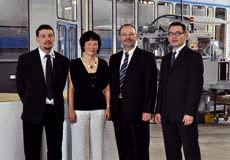Offset Printing
ROTOMAN Open House

Monday 31. August 2009 - It rolls along at Vetters
Combating the crisis with ideas and strength. The Vetters printing company in Radeburg, a town in the German state of Saxony, held an Open House and showed some 500 guests how this can be done in practice. Vetters has expanded its capacity with a 16-page ROTOMAN from manroland. Saxonys Prime Minister Stanislaw Tillich pressed the button to start production.
When a printing company unites farsightedness with cutting-edge technology, this is a special day and marks the beginning of a new era. Almost two years ago, Vetters entered the market for 16-page web offset products with a POLYMAN from manroland. With the ceremonial inauguration of the new ROTOMAN, the capacity for 16-page products at Vetters has been more than doubled. All those invited attended the Open House: customers, fellow printers, suppliers and services providers. The most eminent guest in the newly-built printing hall was Saxonys Prime Minister Stanislaw Tillich who pressed the button to start up the ROTOMAN and thus demonstrated the high regard he has for Vetters entrepreneurial boldness. Tillich explained why he was so keen to perform this task: “Companies that are progressive and prepared to take calculated risks are the crisis-resistant whom one can depend on over the long term.” Behind this compliment stand hard facts, a great deal of work and a strong family-owned business, run by Jürgen Vetters, his wife Rita Vetters, and their sons René and Rico Vetters. Besides the family, 90 employees work in this full-service company including many homegrown vocational trainees. This is a deliberately chosen way to foster the next generation which the Prime Minister paid tribute to and for which the printing company received an award in 2008 as an outstanding vocational training center. The Vetters staff proudly gave the Open House guests a tour of the various departments where mainly commercial printing is produced by sheetfed and web offset. The Radeburg high-end products include brochures, magazines, catalogs, and journals that are primarily for German customers. In future a high proportion of these will be produced on the new ROTOMAN printing system.
Nowhere does the world spin faster than in a printing plant
Why did Vetters choose a ROTOMAN? Managing Director Jürgen Vetters has a very simple answer: “We believe that the ROTOMAN is the best response to the requirements in 16-page web offset printing that have increased dramatically in recent years. It prints both long and short runs efficiently and reliably. Our experience with the POLYMAN technology and the project management and support from manroland made our decision an easy one.” In future Vetters will only need one hour for a run of 55,000 copies with 16 full-color pages – thats almost 15 copies per second. The ROTOMAN is equipped with a semi-automatic plate changing system for fast multi-tasking makereadies. QuickStart features provide automatic pre-inking before production commences so that the press is up to color faster. Precise ink slide presetting with 24 individual ink zone segments, a fast-reacting inking and damping unit for uniform inking, two oscillating form rollers that prevent ghosting, and a high-performance 1:3:3 folder all contribute to the highest level of print quality and folding accuracy.
Vetters goals
Technical Manager Gerd Helwig describes how the companys print quality claim is continually reinforced: “We are a certified quality printer and work in accordance with Process Standard Offset. In May 2009 the Saxon Institute for the Printing Industry confirmed once again that Vetters produces in accordance with DIN EN ISO 12647-2 and DIN ISO 12647-7 in both sheetfed and webfed printing. We have also developed a program for active environment protection and resource conservation.” The most recent example: from March 2008 till March 2009, Vetters took part in the 1st Ecoprofit project of the Meissen district, an environment management approach that is recognized throughout Europe. At the end of the project, savings of 164-megawatt hours of electrical energy, 1,112-megawatt hours of natural gas and 87 tonnes of waste paper shall be conducted.
